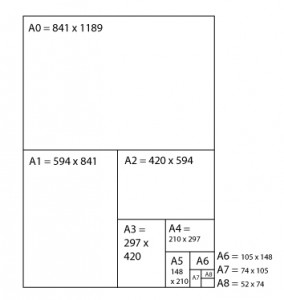 A4 paper is something we’re all familiar with in Australia – we use it in our printers, our photocopiers -but what you may be surprised to learn is that A4 is actually part of an official metric standard.
A4 paper is something we’re all familiar with in Australia – we use it in our printers, our photocopiers -but what you may be surprised to learn is that A4 is actually part of an official metric standard.
In fact, this was set in 1975 when it was based on a German standard that goes all the way back to 1922.
Key Facts and Features of A Series Paper Sizes
- A4 is half the size of A3
- A3 is half the size of A2
- A2 is half the size of A1
- A1 is half the size of A0 (the largest in the range).
A0 is exactly 1m2 of paper (measuring in at 84.1cm x 118.9cm). Metric paper weights are measured in grams per square metre (gsm) and this halving or doubling relationship between each size means that mass calculations of large volumes of paper in the print industry is easy.
Why The A Series of Paper Saves Printers and Designers From Major Headaches
When it comes to the A-series, smaller paper sizes are exactly half the previous paper case every time. This means they are exactly the same shape from one size to the next, with a width-to-height ratio of 1:1:41 at every size. This is a huge help when it comes to resizing images.
To simplify further – an A4 page can be:
- Scaled up by 41% and all artwork and text are the perfect width and height to fill an A3 page
- Scaled down to 71% of its original size to fit perfectly on an A5 page.
This magic number for paper aspect ratio – 1 to the square root of 2 was first suggested all the way back in 1786.
More A Series of Paper Facts at a Glance
- From the 1920s onwards more and more countries chose to adopt the A series
- By 1975 this size of paper was established as an ISO standard and the official United Nations document format
- By 1977 – A4 was the standard letter format in 88 of 148
- Today nearly all nations have adopted the size -except the USA, Canada and most of South America (where ISO is the standard but US sizes are more commonly used).
Some interesting facts and figures – perfect knowledge for your next print job or for scoring a few points at that next trivia night!

